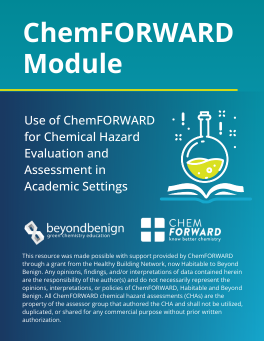ChemFORWARD Module Unit 2: Avoiding Regrettable Substitutions, Natural Is Not Always Safer

Summary
This unit reiterates the importance of avoiding regrettable substitutions, emphasizes the importance of data gaps, and also cautions that naturally-occurring chemicals are not always safer, regardless of the many claims made in some consumer products.
This module unit was reviewed by Julian Silverman (Ph.D.) and Sarah Prescott (Ph.D.).
The inspiration of this work began with a Forsythia Foundation grant to Habitable (formerly Healthy Building Network) to support Beyond Benign and ChemFORWARD to develop a green chemistry curriculum that leverages from Habitable’s Pharos chemical hazards database combined with ChemFORWARD’s safer alternatives.
For Green Chemistry Commitment (GCC) signers interested in short-term access to the ChemFORWARD platform for educational purposes, please contact educator@chemforward.org.
This module unit was reviewed by Julian Silverman (Ph.D.) and Sarah Prescott (Ph.D.).
The inspiration of this work began with a Forsythia Foundation grant to Habitable (formerly Healthy Building Network) to support Beyond Benign and ChemFORWARD to develop a green chemistry curriculum that leverages from Habitable’s Pharos chemical hazards database combined with ChemFORWARD’s safer alternatives.
For Green Chemistry Commitment (GCC) signers interested in short-term access to the ChemFORWARD platform for educational purposes, please contact educator@chemforward.org.
Safety Precautions, Hazards, and Risk Assessment
Not applicable as this module could be used to replace a wet lab.
Teacher Recommendations or Piloting Data (if available)
Some notes from initial piloting of the module:
1. Students in an Environmental Toxicology (18) and an Inorganic Chemistry (18) course were given brief background information and then asked to work on one of the three assignments as homework. The assignments were divided between the student teams to balance, as much as possible, feedback on each assignment. Overall feedback was positive.
2. Students in a General Chemistry II (18) course were presented with selected slides and asked to complete the assignment on deodorants. This assignment was modified to include only 5 ingredients with hazard bands ranging from C to ?. Students worked in teams to complete the assignment during an open lab period. It took the teams about 20 minutes to complete the exercise.
3. The pilot testing of the module (in Fall 2024) for the CHE 371 Green and Sustainable Chemistry Seminar (an undergraduate course with 8 students) took place in an in-class assignment where the educator used the provided PowerPoint slides to facilitate the activity. The educator found the materials met their expectations, particularly appreciating the inclusion of the hazard band assignment that combined GHS hazards with Cradle to Cradle Certified (C2C) health hazards, providing students with a comprehensive understanding of both safety and environmental impacts. However, they suggested adding more detailed explanations of ingredient functions, especially for common ones like cetrimonium chloride, and recommended including a comparison chart to help students identify alternative ingredients. Additionally, the educator proposed developing a decision-making framework to guide students in selecting safer alternatives. A key suggestion was to incorporate information on antimicrobial resistance (AMR), specifically regarding preservatives and antimicrobial agents, to raise awareness about their potential public health risks. Finally, the feedback pointed out gaps in the materials related to commonly used ingredients, recommending their inclusion to enhance the module’s overall effectiveness
4. The pilot testing of the module (in Fall 2024) for the Green Chemistry (CHEM493-2), an upper level undergraduate course with 17 students, which involved both in-class and homework assignments, yielded positive feedback with a few suggestions for improvement. The educator used portions of the provided assignments and presentations, finding that the materials largely met their needs and expectations. They particularly appreciated the background information included in the PowerPoint presentations and the guidance on using the CHEMFORWARD tool. However, the educator suggested that more complex assignments could be included to deepen the learning experience. While they found the CHEMFORWARD site user-friendly overall, they encountered difficulties when searching for safer alternatives to chemicals, specifically for commonly used pesticides. The educator acknowledged that not all chemicals have available safer alternatives, but this limitation was noted as a challenge when using the tool for pesticide selection.Despite this, the educator reported success using CHEMFORWARD as part of a larger lifecycle assessment assignment, noting that it worked well as a complementary resource to other assignments. They also suggested that CHEMFORWARD could be particularly beneficial in an organic chemistry lab setting, where students could use it to assess the hazards of chemicals involved in experiments. Overall, the feedback highlighted that while the module was effective and ChemFORWARD was a valuable tool, there is room for enhancement, particularly in providing more complex assignments and improving the search functionality for safer alternatives. The tool’s integration into lab settings and larger projects was seen as highly beneficial.
1. Students in an Environmental Toxicology (18) and an Inorganic Chemistry (18) course were given brief background information and then asked to work on one of the three assignments as homework. The assignments were divided between the student teams to balance, as much as possible, feedback on each assignment. Overall feedback was positive.
2. Students in a General Chemistry II (18) course were presented with selected slides and asked to complete the assignment on deodorants. This assignment was modified to include only 5 ingredients with hazard bands ranging from C to ?. Students worked in teams to complete the assignment during an open lab period. It took the teams about 20 minutes to complete the exercise.
3. The pilot testing of the module (in Fall 2024) for the CHE 371 Green and Sustainable Chemistry Seminar (an undergraduate course with 8 students) took place in an in-class assignment where the educator used the provided PowerPoint slides to facilitate the activity. The educator found the materials met their expectations, particularly appreciating the inclusion of the hazard band assignment that combined GHS hazards with Cradle to Cradle Certified (C2C) health hazards, providing students with a comprehensive understanding of both safety and environmental impacts. However, they suggested adding more detailed explanations of ingredient functions, especially for common ones like cetrimonium chloride, and recommended including a comparison chart to help students identify alternative ingredients. Additionally, the educator proposed developing a decision-making framework to guide students in selecting safer alternatives. A key suggestion was to incorporate information on antimicrobial resistance (AMR), specifically regarding preservatives and antimicrobial agents, to raise awareness about their potential public health risks. Finally, the feedback pointed out gaps in the materials related to commonly used ingredients, recommending their inclusion to enhance the module’s overall effectiveness
4. The pilot testing of the module (in Fall 2024) for the Green Chemistry (CHEM493-2), an upper level undergraduate course with 17 students, which involved both in-class and homework assignments, yielded positive feedback with a few suggestions for improvement. The educator used portions of the provided assignments and presentations, finding that the materials largely met their needs and expectations. They particularly appreciated the background information included in the PowerPoint presentations and the guidance on using the CHEMFORWARD tool. However, the educator suggested that more complex assignments could be included to deepen the learning experience. While they found the CHEMFORWARD site user-friendly overall, they encountered difficulties when searching for safer alternatives to chemicals, specifically for commonly used pesticides. The educator acknowledged that not all chemicals have available safer alternatives, but this limitation was noted as a challenge when using the tool for pesticide selection.Despite this, the educator reported success using CHEMFORWARD as part of a larger lifecycle assessment assignment, noting that it worked well as a complementary resource to other assignments. They also suggested that CHEMFORWARD could be particularly beneficial in an organic chemistry lab setting, where students could use it to assess the hazards of chemicals involved in experiments. Overall, the feedback highlighted that while the module was effective and ChemFORWARD was a valuable tool, there is room for enhancement, particularly in providing more complex assignments and improving the search functionality for safer alternatives. The tool’s integration into lab settings and larger projects was seen as highly beneficial.
Digital Object Identifier (DOI)
https://doi.org/10.59877/YFOG2801
Other notes/information
Please refer to the instructor's notes before using the module unit.
Any opinions, findings, and/or interpretations of data contained herein are the responsibility of the author(s) and do not necessarily represent the opinions, interpretations, or policies of ChemFORWARD, Habitable, or Beyond Benign. All ChemFORWARD chemical hazard assessments (CHAs) are the property of the assessor group that authored the CHA and shall not be utilized, duplicated, or shared for any commercial purpose without prior written authorization.
Any opinions, findings, and/or interpretations of data contained herein are the responsibility of the author(s) and do not necessarily represent the opinions, interpretations, or policies of ChemFORWARD, Habitable, or Beyond Benign. All ChemFORWARD chemical hazard assessments (CHAs) are the property of the assessor group that authored the CHA and shall not be utilized, duplicated, or shared for any commercial purpose without prior written authorization.
File (PDF, PPT, image, etc)
File (PDF, PPT, image, etc)
Creative Commons License

This work is licensed under a Creative Commons Attribution-NonCommercial-ShareAlike 4.0 International License.




